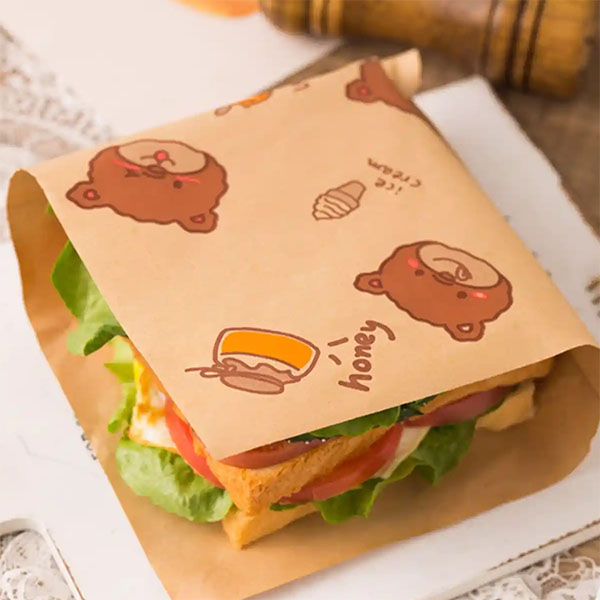Deli sandwich wrap paper is a specialized type of Food Packaging material designed specifically for wrapping sandwiches, burgers, and other handheld food items. Unlike generic wrapping paper, it is engineered with specific properties to maintain food quality, hygiene, and presentation during preparation, storage, and transportation. This paper serves as a critical barrier between the food and the external environment while allowing for breathability in some cases to prevent sogginess.
At its core, deli wrap paper is a multi-laminate material that typically combines paper with other materials like polyethylene (PE) or wax to create a functional barrier with specific properties for food preservation and handling.

Modern deli sandwich wrap papers exhibit several engineered characteristics backed by measurable technical data:
| Characteristic | Technical Data & Specifications |
|---|---|
| Grease Resistance | Rated 3-9 on the Kit Test scale (standard measurement for grease resistance); high-performance varieties can withstand contact with greasy ingredients for up to 24 hours without permeation. |
| Moisture Barrier | Water Vapor Transmission Rate (WVTR) typically ranges from 5-20 g/m²/24hr (at 38°C and 90% RH), effectively preventing moisture migration that causes sogginess while allowing minimal breathability in some varieties. |
| Heat Resistance | Withstands temperatures up to 120°C (248°F) for short periods without degrading, melting, or transferring chemicals to food, making it suitable for wrapping warm ingredients. |
| Tensile Strength | Machine Direction: 4-8 kN/m; Cross Direction: 2-4 kN/m (ensures the paper doesn't tear during wrapping or handling). |
| Basis Weight | Typically ranges from 30-50 g/m², providing durability without excessive bulk or material usage. |
| Food Safety Compliance | Meets FDA 21 CFR 176.170 standards for direct food contact; certified for absence of fluorescent whitening agents (FWAs) and minimal heavy metal content (< 100 ppm total). |
Deli sandwich wrap paper serves numerous applications across the food service industry:
Quick Service Restaurants (QSRs): Major burger chains and sandwich shops utilize customized wrap papers for brand consistency. The paper's grease resistance prevents packaging failure during the critical window between preparation and consumption, while its thermal properties maintain optimal serving temperature. The typical usage rate in high-volume establishments can exceed 1,000 sheets per location daily.
Deli Counters and Supermarkets: Pre-cut sheets or rolls are used for wrapping made-to-order sandwiches. The paper's ability to absorb minimal moisture while providing a barrier helps maintain crispness of lettuce and other vegetables against moist ingredients like tomatoes or condiments. This application requires paper with particularly high wet strength properties to prevent tearing when handling moist ingredients.
Catering and Boxed Lunches: For catering operations, wrap paper provides an initial layer of protection before sandwiches are placed in boxes or platters. The paper's composition prevents transfer of odors between different sandwich types when packed together and minimizes condensation buildup that would otherwise compromise bread texture during transportation.
Food Trucks and Mobile Vendors: The compact storage efficiency of wrap paper rolls (approximately 1,000 sheets per standard roll) makes it ideal for space-constrained operations. Its durability withstands the movement and handling inherent in mobile food service while providing adequate protection from environmental contaminants.
Takeaway and Delivery Services: With the expansion of food delivery platforms, wrap paper serves as the primary protective barrier inside outer packaging. Its grease-resistant properties prevent leakage that could compromise secondary packaging integrity during transportation.
Correct storage and handling of deli wrap paper is essential for maintaining its functional properties and ensuring food safety:
Storage Conditions: Wrap paper should be stored in a cool, dry environment with maintained temperature between 15-25°C (59-77°F) and relative humidity below 65%. Exposure to higher humidity can compromise the paper's structural integrity and reduce its grease resistance properties. Stock should be rotated using the FIFO (first-in, first-out) method to prevent degradation of paper qualities over extended storage periods.
Handling Protocols: Employees should handle wrap paper with clean, dry hands or appropriate utensils to prevent contamination. Bulk rolls should be stored in dedicated dispensers that protect the paper from environmental contaminants while allowing for easy access during food preparation. For operations using pre-cut sheets, these should be stored in covered containers or dispensers that shield them from dust, moisture, and potential splashes.
Contamination Prevention: The storage area should be separate from cleaning chemicals and other non-food items to prevent odor transfer or chemical migration. Wrap paper should never be stored directly on the floor but rather on pallets or shelves at least 15 cm (6 inches) above ground level to prevent pest access and moisture wicking.
Modern deli wrap papers increasingly address environmental concerns through several approaches:
Many manufacturers now offer papers with recycled content ranging from 30-100% post-consumer waste, while maintaining the necessary functional properties for food wrapping applications. The average carbon footprint for production of standard deli wrap paper is approximately 0.8-1.2 kg CO₂ equivalent per kilogram of paper.
Advancements in coating technologies have reduced the amount of polyethylene or wax required for barrier properties, with some premium varieties using bio-based coatings derived from plants like sugarcane. Certain varieties are certified compostable in commercial facilities, meeting standards such as ASTM D6400 or EN 13432, with degradation timelines of 8-12 weeks under appropriate conditions.
The industry is moving toward water-based dispersion coatings instead of solvent-based alternatives, reducing VOC emissions during manufacturing by approximately 40-60% compared to traditional production methods.
Deli sandwich wrap paper represents a sophisticated food packaging solution that balances functional requirements with environmental considerations. Its continued evolution reflects the food service industry's changing needs regarding food safety, convenience, and sustainability. Proper selection and handling of appropriate wrap paper can significantly impact operational efficiency, food quality maintenance, and customer satisfaction.
Previous: Wrap Sheets for Food